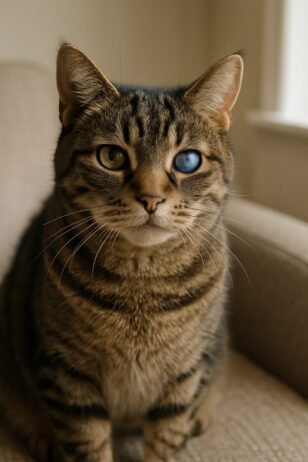Glaucoma in Cats
- 30 September 2025
- BuyAPet Editorial Team
- All Cats, Cat Health, Cats and Dogs
Glaucoma in Cats
Glaucoma is a serious eye condition that can lead to vision loss if left untreated. Learn how to recognise the signs, understand the causes, and explore treatment options to protect your cat’s eye health.
Contents
What is glaucoma?
Glaucoma is an eye condition where increased pressure inside the eye (intraocular pressure) damages the optic nerve, potentially leading to partial or complete vision loss.
It can develop slowly over time or suddenly, making it vital to detect and treat early to save your cat’s sight.
Signs & symptoms of glaucoma
Cloudy or enlarged eye
The affected eye may appear cloudy, bulging, or larger than normal.
Excessive tearing
Watery eyes or persistent discharge can signal irritation or pain.
Pawing at the eye
Cats may paw at their face or keep the affected eye partially closed due to discomfort.
Sensitivity to light
Your cat may squint or avoid bright areas.
Causes of glaucoma in cats
Primary glaucoma
Less common, often inherited and related to abnormal eye structure.
Secondary glaucoma
Triggered by another condition like eye trauma, inflammation, or tumours blocking fluid drainage.
Age factor
More common in older cats, especially over 7 years of age.
Chronic eye diseases
Conditions like uveitis or cataracts can increase the risk of glaucoma.
Treatment options
- Vet diagnosis: Eye pressure tests and exams to confirm glaucoma.
- Medication: Eye drops to reduce pressure and manage discomfort.
- Surgery: In severe cases, surgery may be needed to relieve pressure or remove the eye if blind and painful.
- Ongoing monitoring: Regular vet check-ups to track progress and adjust treatment.
Important: Early detection is crucial to prevent permanent vision loss.
Prevention tips
Routine vet visits
Annual eye exams can help catch glaucoma early.
Monitor for changes
Watch for sudden cloudiness, redness, or behavioural changes like hiding or pawing at the face.
Address underlying conditions
Promptly treat any eye infections or injuries to prevent secondary glaucoma.
Protect senior cats
Older cats are at higher risk, so be extra vigilant with check-ups.
